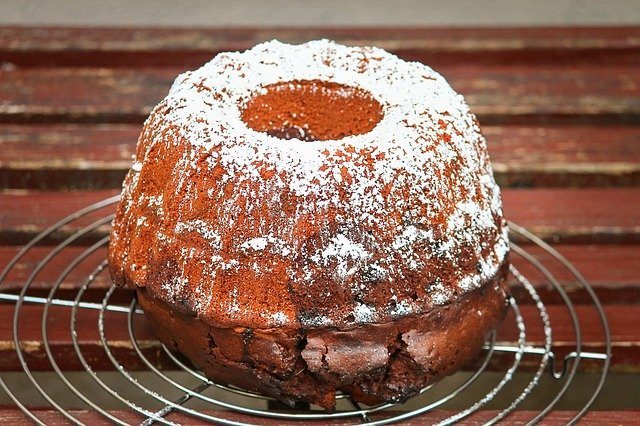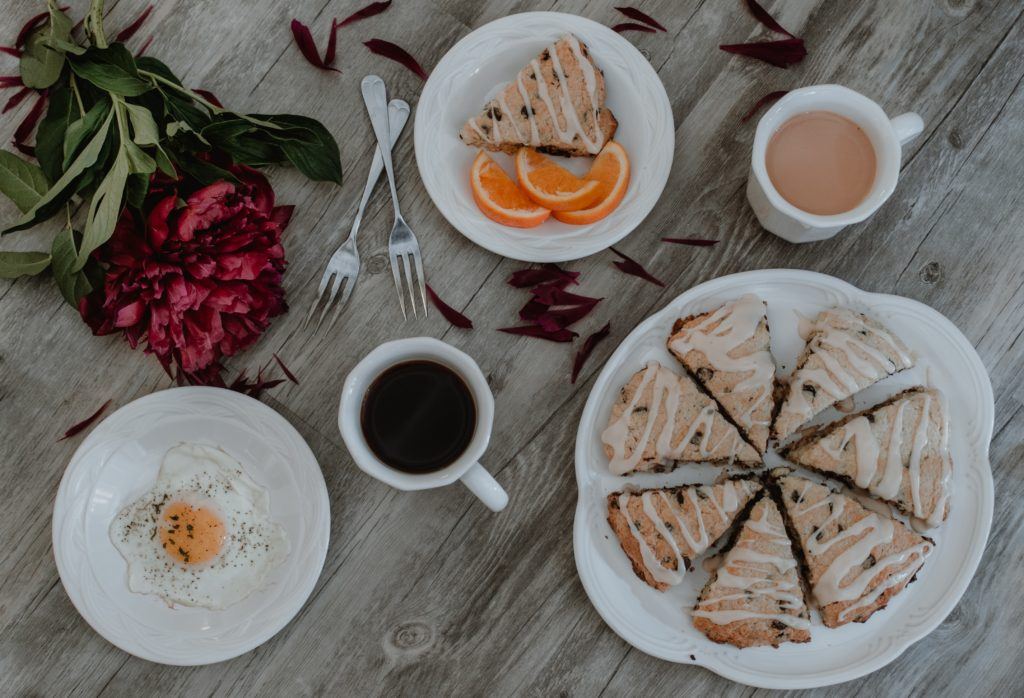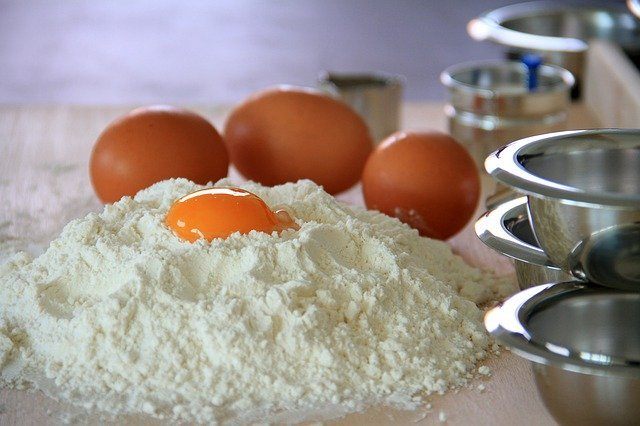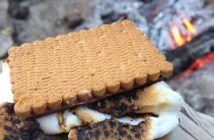When it comes to baking, it pays to be exact. Too much of one ingredient can ruin your bread and make it too hard, too chewy, or too dense. Thankfully, there are ways to help avoid that.
Because baking can be finicky, there are flours specifically developed for certain recipes. How can newbie bakers tell the difference, and choose the right one for the job?
We have all the details you need. Here, we’ll cover the top contenders: pastry flour, cake flour, all-purpose flour, and bread flour. How do they fit into your next baking session?
Let’s find out.
What is Pastry Flour?
Pastry flour is made specifically for baked goods that need a light and fluffy texture. Think of scones, muffins, and pie crusts. But, on a deeper level, how does it vary from other flour types?
The primary difference – among all the flour types, in fact – is the protein count. This protein count is connected to the amount of gluten in the flour. Think of gluten as scaffolding; it expands, creating the air pockets. Paired with the right type of leavening, you can control the texture of your pastry. For example, a flaky, artisanal bread will need ample gluten (using bread flour, for example) and high-power leavening (like yeast).
Pastry flour’s protein count is on the lower end. The scale goes as follows:
- Bread flour: 14 to 16 percent.
- All-purpose flour: 10 to 12 percent.
- Pastry flour: 9 percent.
- Cake flour: 7 to 8 percent.
Where is Pastry Flour Best Used?
As the name implies, pastry flour is used for, well, pastries. Other than pastries, however, you can use this flour to achieve a lighter, fluffier dough.
Some baked goods, including biscuits, quick breads, and pie crusts, do better with a flaky dough that you can only achieve by baking with pastry flour.

Of course, not all baked goods do well with a flakier dough. For example, cinnamon buns and pretzels need a dense, heavy dough; not the best choice for pastry flour.
Pastry Flour vs. All-Purpose Flour
For newbie bakers, it’s best to stick to all-purpose flour. As its name suggests, all-purpose flour can still do a satisfactory job no matter the recipe you apply it to. All-purpose flour is also cheap and readily available, making it the best choice for newbie bakers. After all, mistakes are inevitable, and it’s wise to use cheap flour when learning.
With that said, sometimes you’ll want a flakier dough. If you’re ready to bring your baking skills to the next level, substituting all-purpose flour for other kinds is the next step. We’ll talk about two ways to substitute pastry flour using all-purpose flour below.
Pastry Flour vs. Cake Flour
Of the other common types, cake flour is the closest one to pastry flour. When it comes to protein content, cake flour has even less protein content than its pastry brethren; 7 to 8 percent to be exact.

Because their protein content is very similar, cake flour can be used as a 1:1 pastry flour substitute. In other words, with recipes calling for pastry flour, you can substitute it with cake flour without adding or removing anything. Your pastry will turn out fine, although it may be a bit more moist, less flaky, and more crumbly than if you used pastry flour.
Nonetheless, this is a good alternative for those who want a quick substitution—or if you have a lot of cake flour lying around.
Pastry Flour vs. Bread Flour
All-purpose flour and cake flour can be used as a pastry flour substitute; bread flour, on the other hand, is different. Because of its high protein content at 11-13 percent (with some brands ranging from 14 to 16 percent), this flour is too dense to create the flaky texture that you need in pastries. In fact, using bread flour for pastries can result in rock hard, inedible mistakes—and no one wants that.

Bread flour can be substituted all-purpose flour (although expect the texture to be more chewy and dense). In fact, some baked goods, like pizza crusts, can be made better with a bread flour substitution. However, it cannot be substituted for cake flour or pastry flour.
Whole Wheat Pastry Flour
For those who would like a healthier version of their favorite pastries, you can also use whole wheat pastry flour. Like other types of whole wheat flour, whole wheat pastry flour is milled using whole wheat, making it healthier and more nutritious. Whole wheat pastry flour is also known as graham flour and soft wheat pastry flour.
Like the regular pastry kind, whole wheat pastry flour has a lower protein content. It is milled using low-protein spring wheat, compared to the high-protein winter wheat that is used for all-purpose whole wheat flour.
How to Make Pastry Flour
Compared to other types, pastry flour can be more expensive and harder to find. As we’ve said, you can substitute it for other varieties – but this may create a difference in your results. For those who would like a closer texture, you can mix all-purpose flour with a bit of starch to create your own pastry flour. We have two approaches below:
How to Make Pastry Flour Using All-Purpose Flour
For those who want a quick substitution, you can combine all-purpose flour and cornstarch to create a homemade pastry flour. Combining AP flour and cornstarch achieves two things: First, all-purpose flour provides the gluten content in our homemade version. Because we don’t use a full cup, the gluten content between a cup of AP flour and a cup of pastry flour evens out. Second, the cornstarch provides the high starch content in pastry flour; this is what elevates this substitution than by substituting pastry flour with just AP flour.
Ingredients
- 5/8 cup of all-purpose flour, preferably unbleached.
- 2 ½ teaspoons of cornstarch.
Procedure
- First, measure out 5/8 cup of all-purpose flour. Since precision will be key, but sure to dip a measuring cup into the flour and then level it with a spatula or the straight edge of a knife. Put the excess flour back in the container.
- Place your flour in a bowl. Then, remove 2 ½ teaspoons of flour from the bowl and return it to your container.
- Replace this with 2 ½ teaspoons of cornstarch.
- Then whisk! You will need to whisk for a while to make sure that the flour and cornstarch are properly incorporated.
- Sift the flour. This will add air to the mixture and ensure the two ingredients are further incorporated.
- Mix the flour again, and sift a second time. Continue mixing and sifting about five to six times in total.
- Transfer your homemade flour mixture into a bowl, and label it.
How to Make Pastry Flour Using Tapioca Flour
For those who want a corn-free version, this recipe uses tapioca flour instead of cornstarch. Like cornstarch, tapioca flour is a pure starch—but it doesn’t contain any corn. Being a major allergen, it’s best to avoid corn when baking for a large group or for those with specific intolerances. Check out the original post for more information on how this recipe was developed.
Ingredients
- 2 ¼ cups, plus 1 tablespoon of all-purpose flour, unbleached.
- 2 ½ teaspoons of tapioca flour.
Procedure
- Measure out all-purpose flour and tapioca flour in a medium to large bowl.
- Mix until well-blended.
- Sift the flour using a sifter or fine-mesh sieve five to six times. Mix the flour by hand in between sifts.
- Transfer the flour into an air-tight container.
How to Make Whole Wheat Pastry Flour
Like regular pastry flour, you can substitute whole wheat pastry flour with whole wheat cake flour (but expect the outcome to be a bit more moist.) For those who would like a version closer to the original, we have the recipe for you.
Ingredients
- ½ cup of cake flour.
- ½ cup of whole wheat all-purpose flour.
- 2 tablespoons of cornstarch.
Procedure
- Measure out both the cake flour and whole wheat flour. Remove one tablespoon from each, and return the tablespoon to the container.
- Put the cake flour, whole wheat all-purpose flour, and cornstarch into a medium-sized bowl. Mix well.
- Sift the flour about five times, hand-mixing in between sifts.
- Store the flour in a container.
Storage
Your homemade pastry flour will store just like most types of flour. Put your homemade pastry flour in an air-tight container and store it in a cool, dry place. This flour will keep for a few months or up to a year, depending on the moisture levels present.
Baking Ideas and Recipes
For those who want to use pastry flour in their baking, you’re in for a treat. Pastry flour can serve as a substitute in almost any pastry recipe, so long as you want a flakier dough. Recipes that call for cake flour can be substituted for pastry flour 1:1, while you can substitute other flour types with a bit of experimentation.
The Best Buttery Scones
If you want to experiment with pastry flour a bit further, this recipe may be right up your alley. The ingredient list originally calls for cake flour and all-purpose flour, but you can safely switch out these types with an equal amount of pastry flour. As a bonus, you can save time cleaning up with just one type of flour.

You can bake either version — one with the substitution and one without — and see for yourself how different flours change the outcome of your treats.
Ingredients
- ½ cup of dried currants.
- Juice and zest of half a small lemon.
- 1 cup of heavy cream, chilled.
- 2 large egg yolks.
- 3 cups of pastry flour, plus more for dusting.
- ¼ cup of sugar.
- 1 tablespoon of baking powder.
- ¾ teaspoon of baking soda.
- 1 teaspoon of salt.
- 2/4 cup of unsalted butter, chilled.
- 3 tablespoons of unsalted butter, melted.
- ¼ cup of turbinado sugar (optional).
Procedure
- Soak your currants in a small, non-reactive bowl. Add lemon juice and zest, and stir well. Let stand for 35 to 40 minutes, until currants have rehydrated.
- Preheat your oven to 400 degrees Fahrenheit. Spray a rimmed baking sheet with non-stick baking spray or vegetable oil. Set aside.
- Sift the dry ingredients. If using a stand mixer, fit with a paddle attachment. If using a food processor, fit with a metal blade.
- Cut the butter into ½ inch chunks, and add into the flour. If using a stand mixer, mix at medium-low speed for 30 seconds. If using a food processor, process in eight one-second pulses. Your dough should be powdery in some spots and coarse in other parts. Be sure not to overmix.
- Add the eggs. Mix at medium speed for 30 to 45 seconds. Alternatively, process in four one-second pulses. The dough should just barely come together with lumpy edges.
- Dust a work surface with flour, and scoop the dough onto your surface. Scatter the currants and zest on top. Gently fold in the currants and zest.
- Divide the dough in half. Sprinkle a pinch of flour on top of one of the halves. Shape into a six to seven-inch balls that are about ½ inch thick. Do the same for the other half of the dough.
- Cut each circle into six even wedges, using a pizza wheel if possible. Make sure to cut through all layers.
- Lift the wedges one at a time and place them on your baking sheet, making sure to keep a space of about ½ inch to ¾ inch per wedge.
- Brush the tops of each scone with melted butter. If desired, sprinkle the tops with sugar.
- Bake the scones for about 15 to 18 minutes, until the tops become golden-brown.
Conclusion
Flour is one of the most important parts of baking, and it pays to understand how it works. When it comes to pastries, pastry flour can truly elevate your baking, giving you the perfect, fluffy, flaky texture. The next time you’re baking, why not consider substituting the flour in your recipe for pastry flour?






